Psychotropic Medications and Mental Health: A Critical Analysis
VerifiedAdded on 2022/08/27
|12
|3561
|9
Essay
AI Summary
This essay critically examines the ongoing controversy surrounding the use of psychotropic medications in mental health, focusing on the ethical and legal concerns associated with their application. The paper explores the impact of these medications on patients, considering both their potential benefits in managing symptoms and the associated risks, including side effects and the violation of human rights. The essay discusses the perspectives of healthcare professionals, particularly registered nurses, highlighting the challenges they face in administering these medications, including patient refusal, safety concerns, and the need for balancing patient rights with the need for care. It also addresses the role of social stigma and cultural considerations in the context of mental health treatment, emphasizing the importance of informed consent and the need for a recovery-oriented approach. The essay draws upon national and international perspectives within contemporary literature to provide a comprehensive analysis of the complexities surrounding the use of psychotropic drugs and chemical restraints in mental health settings. The paper highlights the need for healthcare professionals to provide psychotropic medications according to patients’ with respect to their medical conditions, their stigma and rights and also considers alternative methods to coercive practices.
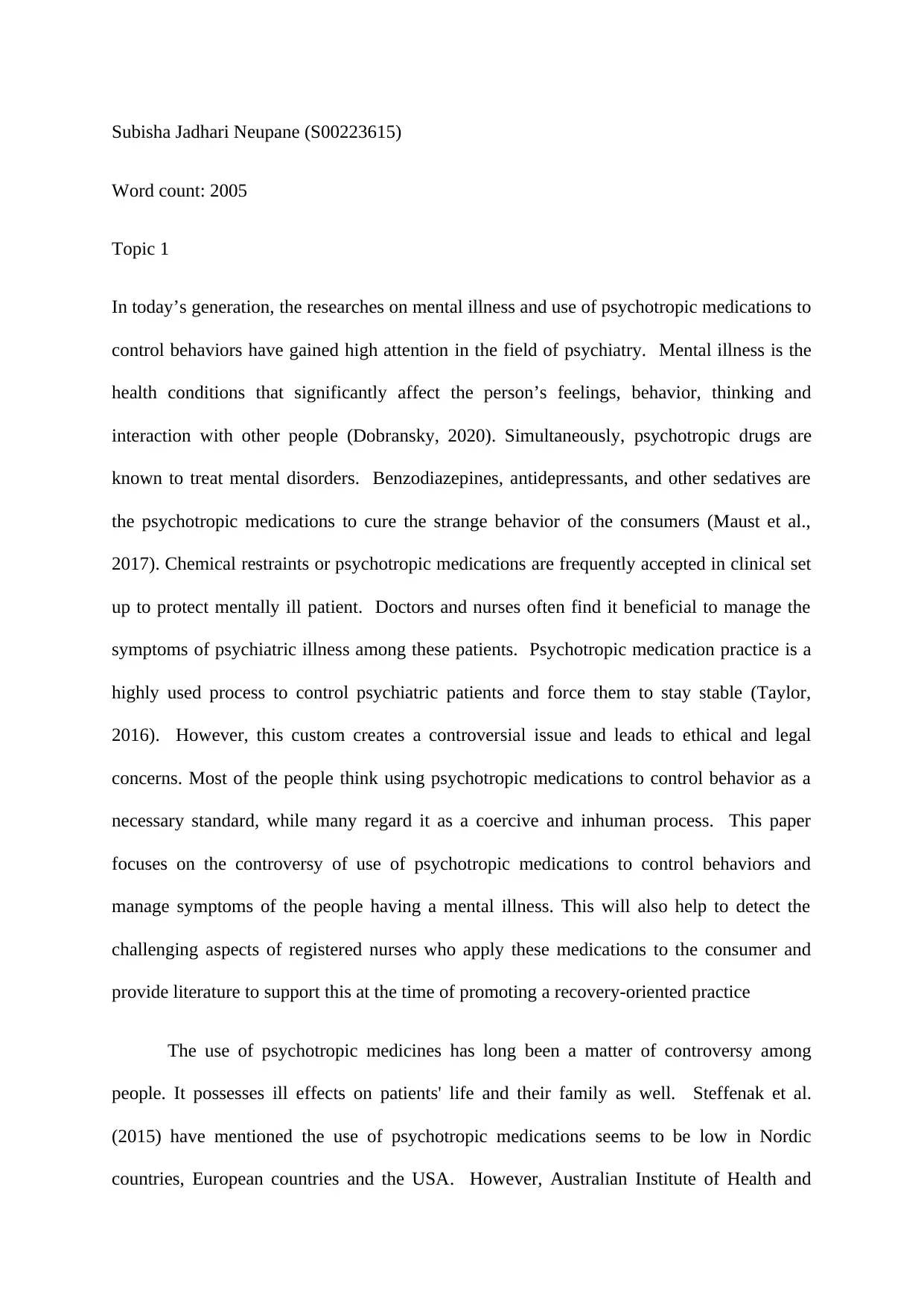
Subisha Jadhari Neupane (S00223615)
Word count: 2005
Topic 1
In today’s generation, the researches on mental illness and use of psychotropic medications to
control behaviors have gained high attention in the field of psychiatry. Mental illness is the
health conditions that significantly affect the person’s feelings, behavior, thinking and
interaction with other people (Dobransky, 2020). Simultaneously, psychotropic drugs are
known to treat mental disorders. Benzodiazepines, antidepressants, and other sedatives are
the psychotropic medications to cure the strange behavior of the consumers (Maust et al.,
2017). Chemical restraints or psychotropic medications are frequently accepted in clinical set
up to protect mentally ill patient. Doctors and nurses often find it beneficial to manage the
symptoms of psychiatric illness among these patients. Psychotropic medication practice is a
highly used process to control psychiatric patients and force them to stay stable (Taylor,
2016). However, this custom creates a controversial issue and leads to ethical and legal
concerns. Most of the people think using psychotropic medications to control behavior as a
necessary standard, while many regard it as a coercive and inhuman process. This paper
focuses on the controversy of use of psychotropic medications to control behaviors and
manage symptoms of the people having a mental illness. This will also help to detect the
challenging aspects of registered nurses who apply these medications to the consumer and
provide literature to support this at the time of promoting a recovery-oriented practice
The use of psychotropic medicines has long been a matter of controversy among
people. It possesses ill effects on patients' life and their family as well. Steffenak et al.
(2015) have mentioned the use of psychotropic medications seems to be low in Nordic
countries, European countries and the USA. However, Australian Institute of Health and
Word count: 2005
Topic 1
In today’s generation, the researches on mental illness and use of psychotropic medications to
control behaviors have gained high attention in the field of psychiatry. Mental illness is the
health conditions that significantly affect the person’s feelings, behavior, thinking and
interaction with other people (Dobransky, 2020). Simultaneously, psychotropic drugs are
known to treat mental disorders. Benzodiazepines, antidepressants, and other sedatives are
the psychotropic medications to cure the strange behavior of the consumers (Maust et al.,
2017). Chemical restraints or psychotropic medications are frequently accepted in clinical set
up to protect mentally ill patient. Doctors and nurses often find it beneficial to manage the
symptoms of psychiatric illness among these patients. Psychotropic medication practice is a
highly used process to control psychiatric patients and force them to stay stable (Taylor,
2016). However, this custom creates a controversial issue and leads to ethical and legal
concerns. Most of the people think using psychotropic medications to control behavior as a
necessary standard, while many regard it as a coercive and inhuman process. This paper
focuses on the controversy of use of psychotropic medications to control behaviors and
manage symptoms of the people having a mental illness. This will also help to detect the
challenging aspects of registered nurses who apply these medications to the consumer and
provide literature to support this at the time of promoting a recovery-oriented practice
The use of psychotropic medicines has long been a matter of controversy among
people. It possesses ill effects on patients' life and their family as well. Steffenak et al.
(2015) have mentioned the use of psychotropic medications seems to be low in Nordic
countries, European countries and the USA. However, Australian Institute of Health and
Paraphrase This Document
Need a fresh take? Get an instant paraphrase of this document with our AI Paraphraser
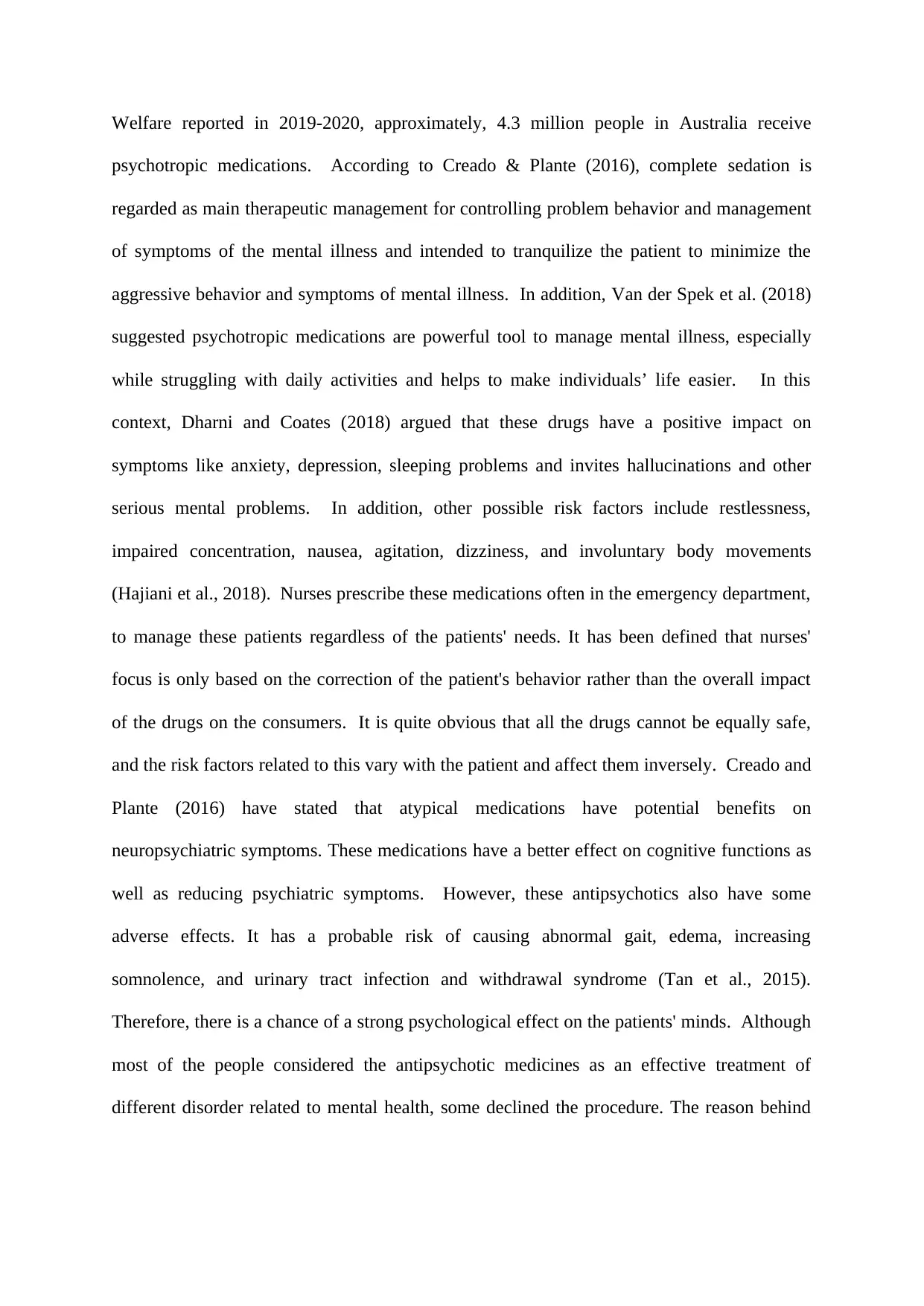
Welfare reported in 2019-2020, approximately, 4.3 million people in Australia receive
psychotropic medications. According to Creado & Plante (2016), complete sedation is
regarded as main therapeutic management for controlling problem behavior and management
of symptoms of the mental illness and intended to tranquilize the patient to minimize the
aggressive behavior and symptoms of mental illness. In addition, Van der Spek et al. (2018)
suggested psychotropic medications are powerful tool to manage mental illness, especially
while struggling with daily activities and helps to make individuals’ life easier. In this
context, Dharni and Coates (2018) argued that these drugs have a positive impact on
symptoms like anxiety, depression, sleeping problems and invites hallucinations and other
serious mental problems. In addition, other possible risk factors include restlessness,
impaired concentration, nausea, agitation, dizziness, and involuntary body movements
(Hajiani et al., 2018). Nurses prescribe these medications often in the emergency department,
to manage these patients regardless of the patients' needs. It has been defined that nurses'
focus is only based on the correction of the patient's behavior rather than the overall impact
of the drugs on the consumers. It is quite obvious that all the drugs cannot be equally safe,
and the risk factors related to this vary with the patient and affect them inversely. Creado and
Plante (2016) have stated that atypical medications have potential benefits on
neuropsychiatric symptoms. These medications have a better effect on cognitive functions as
well as reducing psychiatric symptoms. However, these antipsychotics also have some
adverse effects. It has a probable risk of causing abnormal gait, edema, increasing
somnolence, and urinary tract infection and withdrawal syndrome (Tan et al., 2015).
Therefore, there is a chance of a strong psychological effect on the patients' minds. Although
most of the people considered the antipsychotic medicines as an effective treatment of
different disorder related to mental health, some declined the procedure. The reason behind
psychotropic medications. According to Creado & Plante (2016), complete sedation is
regarded as main therapeutic management for controlling problem behavior and management
of symptoms of the mental illness and intended to tranquilize the patient to minimize the
aggressive behavior and symptoms of mental illness. In addition, Van der Spek et al. (2018)
suggested psychotropic medications are powerful tool to manage mental illness, especially
while struggling with daily activities and helps to make individuals’ life easier. In this
context, Dharni and Coates (2018) argued that these drugs have a positive impact on
symptoms like anxiety, depression, sleeping problems and invites hallucinations and other
serious mental problems. In addition, other possible risk factors include restlessness,
impaired concentration, nausea, agitation, dizziness, and involuntary body movements
(Hajiani et al., 2018). Nurses prescribe these medications often in the emergency department,
to manage these patients regardless of the patients' needs. It has been defined that nurses'
focus is only based on the correction of the patient's behavior rather than the overall impact
of the drugs on the consumers. It is quite obvious that all the drugs cannot be equally safe,
and the risk factors related to this vary with the patient and affect them inversely. Creado and
Plante (2016) have stated that atypical medications have potential benefits on
neuropsychiatric symptoms. These medications have a better effect on cognitive functions as
well as reducing psychiatric symptoms. However, these antipsychotics also have some
adverse effects. It has a probable risk of causing abnormal gait, edema, increasing
somnolence, and urinary tract infection and withdrawal syndrome (Tan et al., 2015).
Therefore, there is a chance of a strong psychological effect on the patients' minds. Although
most of the people considered the antipsychotic medicines as an effective treatment of
different disorder related to mental health, some declined the procedure. The reason behind
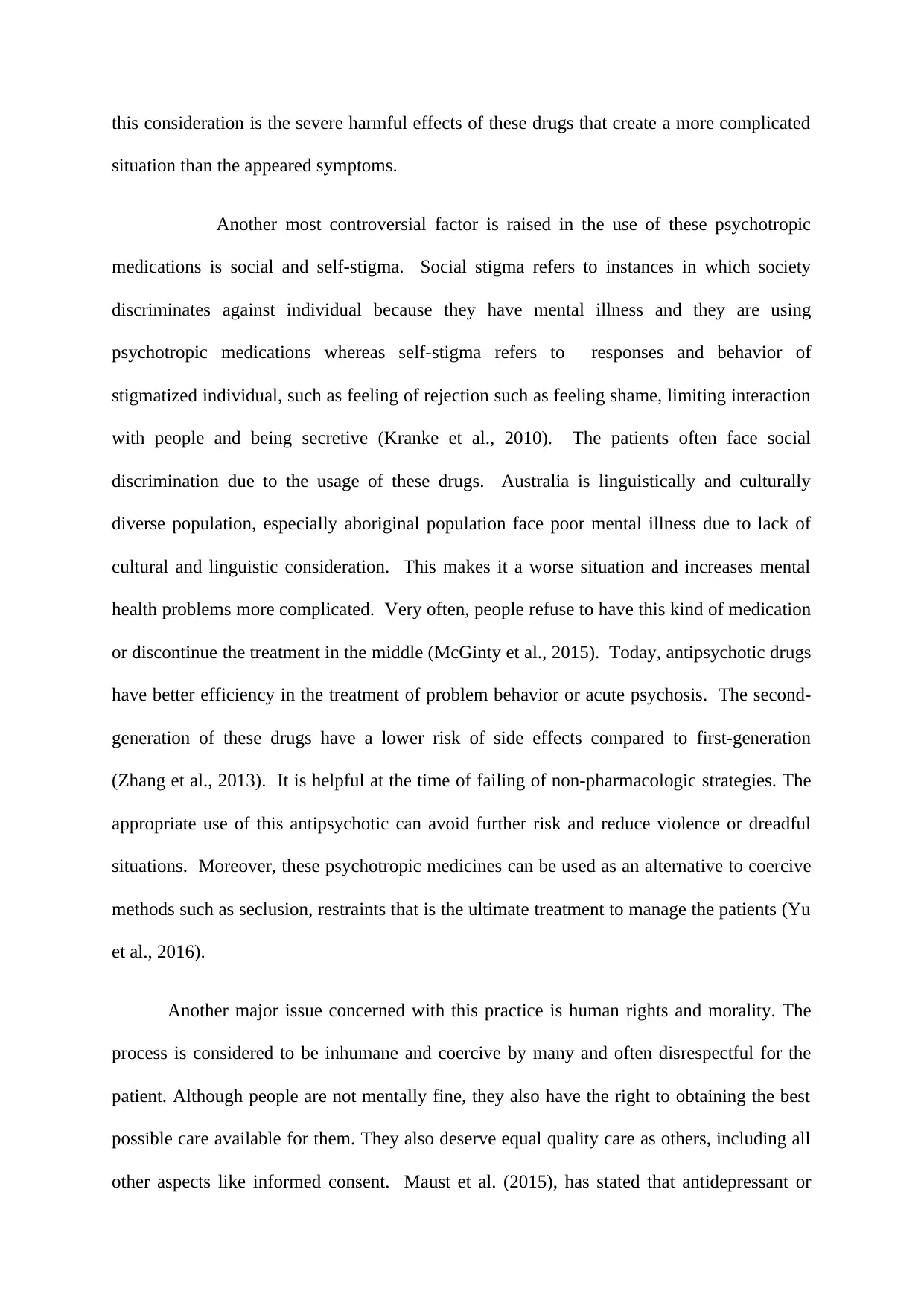
this consideration is the severe harmful effects of these drugs that create a more complicated
situation than the appeared symptoms.
Another most controversial factor is raised in the use of these psychotropic
medications is social and self-stigma. Social stigma refers to instances in which society
discriminates against individual because they have mental illness and they are using
psychotropic medications whereas self-stigma refers to responses and behavior of
stigmatized individual, such as feeling of rejection such as feeling shame, limiting interaction
with people and being secretive (Kranke et al., 2010). The patients often face social
discrimination due to the usage of these drugs. Australia is linguistically and culturally
diverse population, especially aboriginal population face poor mental illness due to lack of
cultural and linguistic consideration. This makes it a worse situation and increases mental
health problems more complicated. Very often, people refuse to have this kind of medication
or discontinue the treatment in the middle (McGinty et al., 2015). Today, antipsychotic drugs
have better efficiency in the treatment of problem behavior or acute psychosis. The second-
generation of these drugs have a lower risk of side effects compared to first-generation
(Zhang et al., 2013). It is helpful at the time of failing of non-pharmacologic strategies. The
appropriate use of this antipsychotic can avoid further risk and reduce violence or dreadful
situations. Moreover, these psychotropic medicines can be used as an alternative to coercive
methods such as seclusion, restraints that is the ultimate treatment to manage the patients (Yu
et al., 2016).
Another major issue concerned with this practice is human rights and morality. The
process is considered to be inhumane and coercive by many and often disrespectful for the
patient. Although people are not mentally fine, they also have the right to obtaining the best
possible care available for them. They also deserve equal quality care as others, including all
other aspects like informed consent. Maust et al. (2015), has stated that antidepressant or
situation than the appeared symptoms.
Another most controversial factor is raised in the use of these psychotropic
medications is social and self-stigma. Social stigma refers to instances in which society
discriminates against individual because they have mental illness and they are using
psychotropic medications whereas self-stigma refers to responses and behavior of
stigmatized individual, such as feeling of rejection such as feeling shame, limiting interaction
with people and being secretive (Kranke et al., 2010). The patients often face social
discrimination due to the usage of these drugs. Australia is linguistically and culturally
diverse population, especially aboriginal population face poor mental illness due to lack of
cultural and linguistic consideration. This makes it a worse situation and increases mental
health problems more complicated. Very often, people refuse to have this kind of medication
or discontinue the treatment in the middle (McGinty et al., 2015). Today, antipsychotic drugs
have better efficiency in the treatment of problem behavior or acute psychosis. The second-
generation of these drugs have a lower risk of side effects compared to first-generation
(Zhang et al., 2013). It is helpful at the time of failing of non-pharmacologic strategies. The
appropriate use of this antipsychotic can avoid further risk and reduce violence or dreadful
situations. Moreover, these psychotropic medicines can be used as an alternative to coercive
methods such as seclusion, restraints that is the ultimate treatment to manage the patients (Yu
et al., 2016).
Another major issue concerned with this practice is human rights and morality. The
process is considered to be inhumane and coercive by many and often disrespectful for the
patient. Although people are not mentally fine, they also have the right to obtaining the best
possible care available for them. They also deserve equal quality care as others, including all
other aspects like informed consent. Maust et al. (2015), has stated that antidepressant or
⊘ This is a preview!⊘
Do you want full access?
Subscribe today to unlock all pages.

Trusted by 1+ million students worldwide
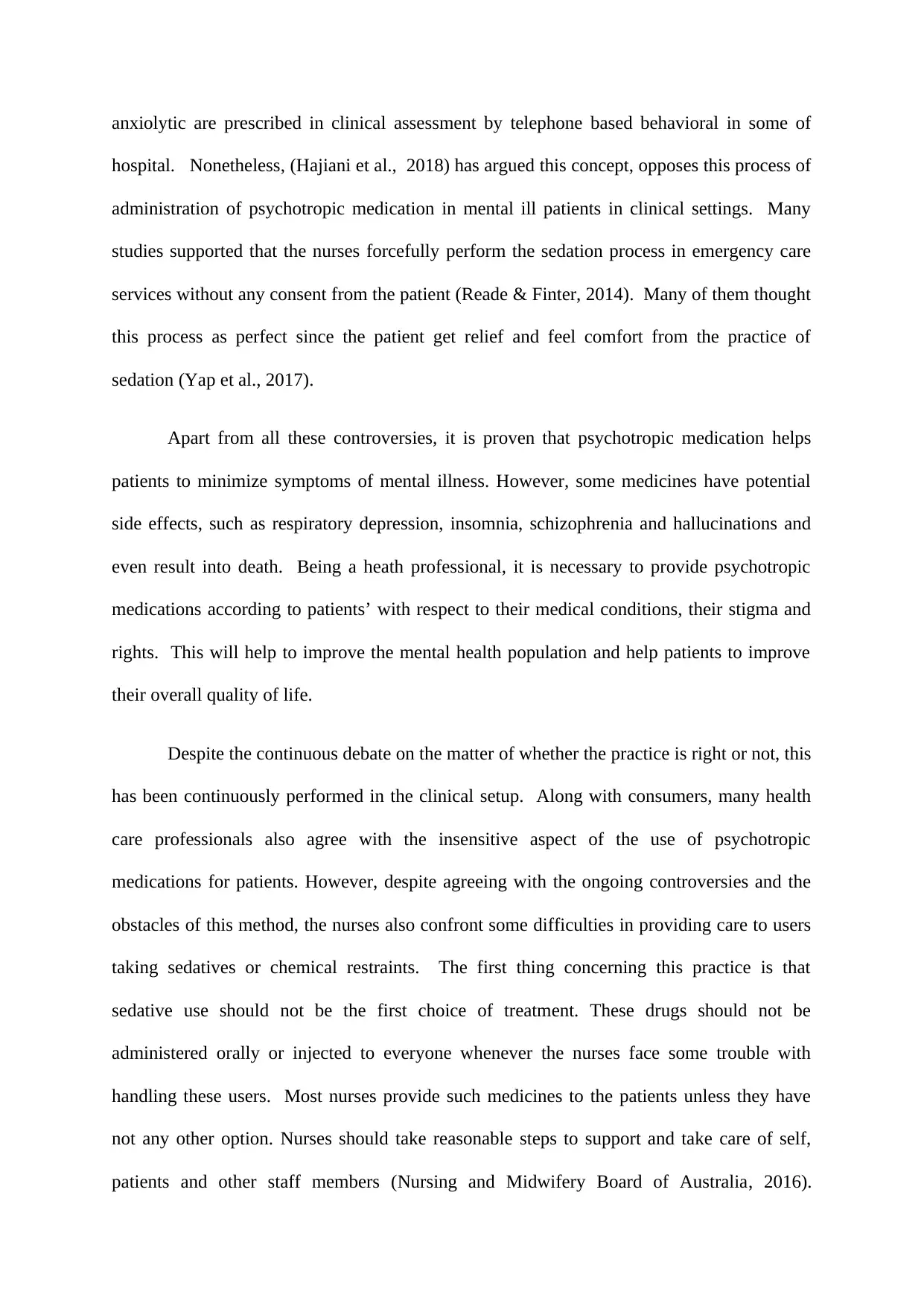
anxiolytic are prescribed in clinical assessment by telephone based behavioral in some of
hospital. Nonetheless, (Hajiani et al., 2018) has argued this concept, opposes this process of
administration of psychotropic medication in mental ill patients in clinical settings. Many
studies supported that the nurses forcefully perform the sedation process in emergency care
services without any consent from the patient (Reade & Finter, 2014). Many of them thought
this process as perfect since the patient get relief and feel comfort from the practice of
sedation (Yap et al., 2017).
Apart from all these controversies, it is proven that psychotropic medication helps
patients to minimize symptoms of mental illness. However, some medicines have potential
side effects, such as respiratory depression, insomnia, schizophrenia and hallucinations and
even result into death. Being a heath professional, it is necessary to provide psychotropic
medications according to patients’ with respect to their medical conditions, their stigma and
rights. This will help to improve the mental health population and help patients to improve
their overall quality of life.
Despite the continuous debate on the matter of whether the practice is right or not, this
has been continuously performed in the clinical setup. Along with consumers, many health
care professionals also agree with the insensitive aspect of the use of psychotropic
medications for patients. However, despite agreeing with the ongoing controversies and the
obstacles of this method, the nurses also confront some difficulties in providing care to users
taking sedatives or chemical restraints. The first thing concerning this practice is that
sedative use should not be the first choice of treatment. These drugs should not be
administered orally or injected to everyone whenever the nurses face some trouble with
handling these users. Most nurses provide such medicines to the patients unless they have
not any other option. Nurses should take reasonable steps to support and take care of self,
patients and other staff members (Nursing and Midwifery Board of Australia, 2016).
hospital. Nonetheless, (Hajiani et al., 2018) has argued this concept, opposes this process of
administration of psychotropic medication in mental ill patients in clinical settings. Many
studies supported that the nurses forcefully perform the sedation process in emergency care
services without any consent from the patient (Reade & Finter, 2014). Many of them thought
this process as perfect since the patient get relief and feel comfort from the practice of
sedation (Yap et al., 2017).
Apart from all these controversies, it is proven that psychotropic medication helps
patients to minimize symptoms of mental illness. However, some medicines have potential
side effects, such as respiratory depression, insomnia, schizophrenia and hallucinations and
even result into death. Being a heath professional, it is necessary to provide psychotropic
medications according to patients’ with respect to their medical conditions, their stigma and
rights. This will help to improve the mental health population and help patients to improve
their overall quality of life.
Despite the continuous debate on the matter of whether the practice is right or not, this
has been continuously performed in the clinical setup. Along with consumers, many health
care professionals also agree with the insensitive aspect of the use of psychotropic
medications for patients. However, despite agreeing with the ongoing controversies and the
obstacles of this method, the nurses also confront some difficulties in providing care to users
taking sedatives or chemical restraints. The first thing concerning this practice is that
sedative use should not be the first choice of treatment. These drugs should not be
administered orally or injected to everyone whenever the nurses face some trouble with
handling these users. Most nurses provide such medicines to the patients unless they have
not any other option. Nurses should take reasonable steps to support and take care of self,
patients and other staff members (Nursing and Midwifery Board of Australia, 2016).
Paraphrase This Document
Need a fresh take? Get an instant paraphrase of this document with our AI Paraphraser
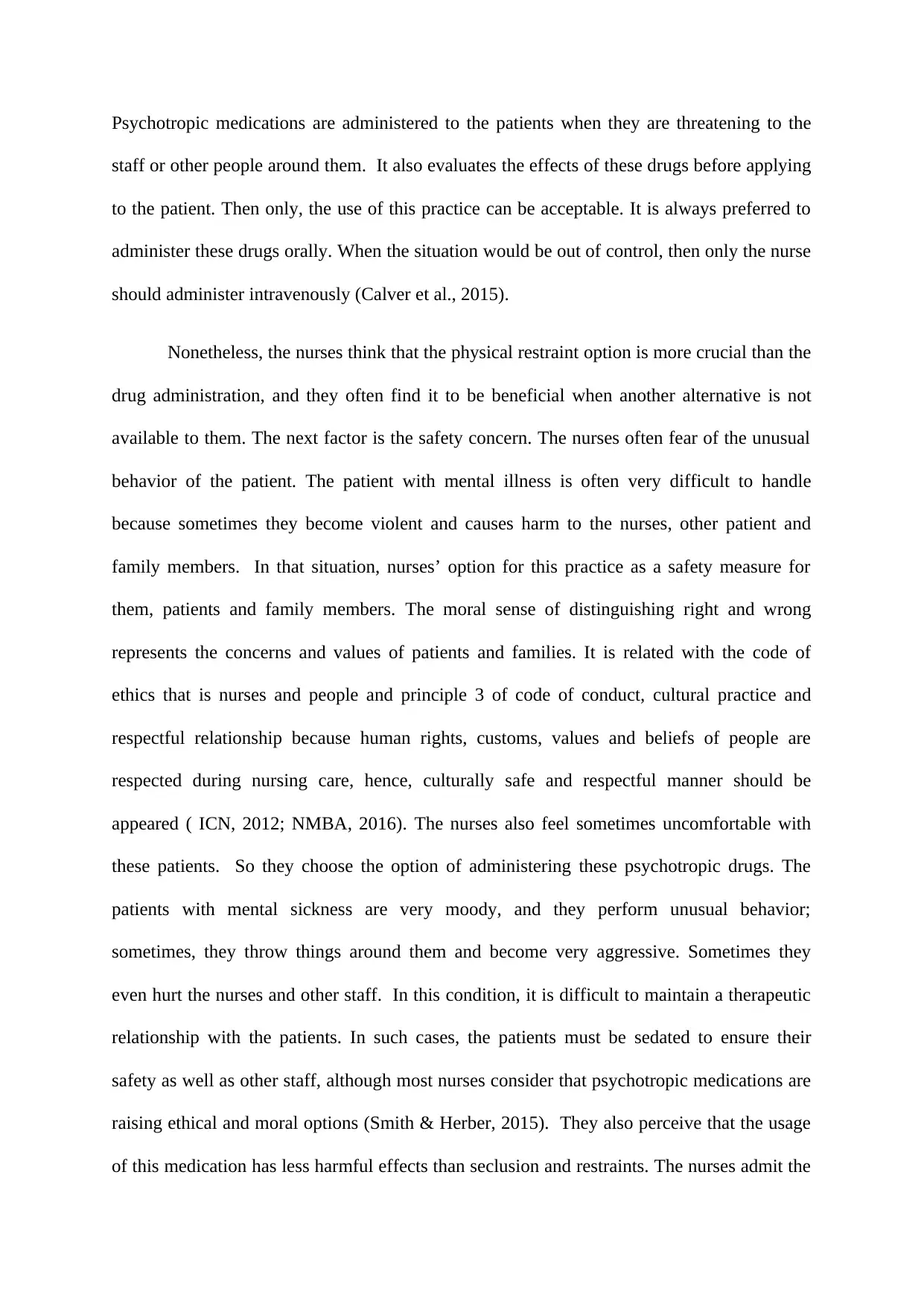
Psychotropic medications are administered to the patients when they are threatening to the
staff or other people around them. It also evaluates the effects of these drugs before applying
to the patient. Then only, the use of this practice can be acceptable. It is always preferred to
administer these drugs orally. When the situation would be out of control, then only the nurse
should administer intravenously (Calver et al., 2015).
Nonetheless, the nurses think that the physical restraint option is more crucial than the
drug administration, and they often find it to be beneficial when another alternative is not
available to them. The next factor is the safety concern. The nurses often fear of the unusual
behavior of the patient. The patient with mental illness is often very difficult to handle
because sometimes they become violent and causes harm to the nurses, other patient and
family members. In that situation, nurses’ option for this practice as a safety measure for
them, patients and family members. The moral sense of distinguishing right and wrong
represents the concerns and values of patients and families. It is related with the code of
ethics that is nurses and people and principle 3 of code of conduct, cultural practice and
respectful relationship because human rights, customs, values and beliefs of people are
respected during nursing care, hence, culturally safe and respectful manner should be
appeared ( ICN, 2012; NMBA, 2016). The nurses also feel sometimes uncomfortable with
these patients. So they choose the option of administering these psychotropic drugs. The
patients with mental sickness are very moody, and they perform unusual behavior;
sometimes, they throw things around them and become very aggressive. Sometimes they
even hurt the nurses and other staff. In this condition, it is difficult to maintain a therapeutic
relationship with the patients. In such cases, the patients must be sedated to ensure their
safety as well as other staff, although most nurses consider that psychotropic medications are
raising ethical and moral options (Smith & Herber, 2015). They also perceive that the usage
of this medication has less harmful effects than seclusion and restraints. The nurses admit the
staff or other people around them. It also evaluates the effects of these drugs before applying
to the patient. Then only, the use of this practice can be acceptable. It is always preferred to
administer these drugs orally. When the situation would be out of control, then only the nurse
should administer intravenously (Calver et al., 2015).
Nonetheless, the nurses think that the physical restraint option is more crucial than the
drug administration, and they often find it to be beneficial when another alternative is not
available to them. The next factor is the safety concern. The nurses often fear of the unusual
behavior of the patient. The patient with mental illness is often very difficult to handle
because sometimes they become violent and causes harm to the nurses, other patient and
family members. In that situation, nurses’ option for this practice as a safety measure for
them, patients and family members. The moral sense of distinguishing right and wrong
represents the concerns and values of patients and families. It is related with the code of
ethics that is nurses and people and principle 3 of code of conduct, cultural practice and
respectful relationship because human rights, customs, values and beliefs of people are
respected during nursing care, hence, culturally safe and respectful manner should be
appeared ( ICN, 2012; NMBA, 2016). The nurses also feel sometimes uncomfortable with
these patients. So they choose the option of administering these psychotropic drugs. The
patients with mental sickness are very moody, and they perform unusual behavior;
sometimes, they throw things around them and become very aggressive. Sometimes they
even hurt the nurses and other staff. In this condition, it is difficult to maintain a therapeutic
relationship with the patients. In such cases, the patients must be sedated to ensure their
safety as well as other staff, although most nurses consider that psychotropic medications are
raising ethical and moral options (Smith & Herber, 2015). They also perceive that the usage
of this medication has less harmful effects than seclusion and restraints. The nurses admit the
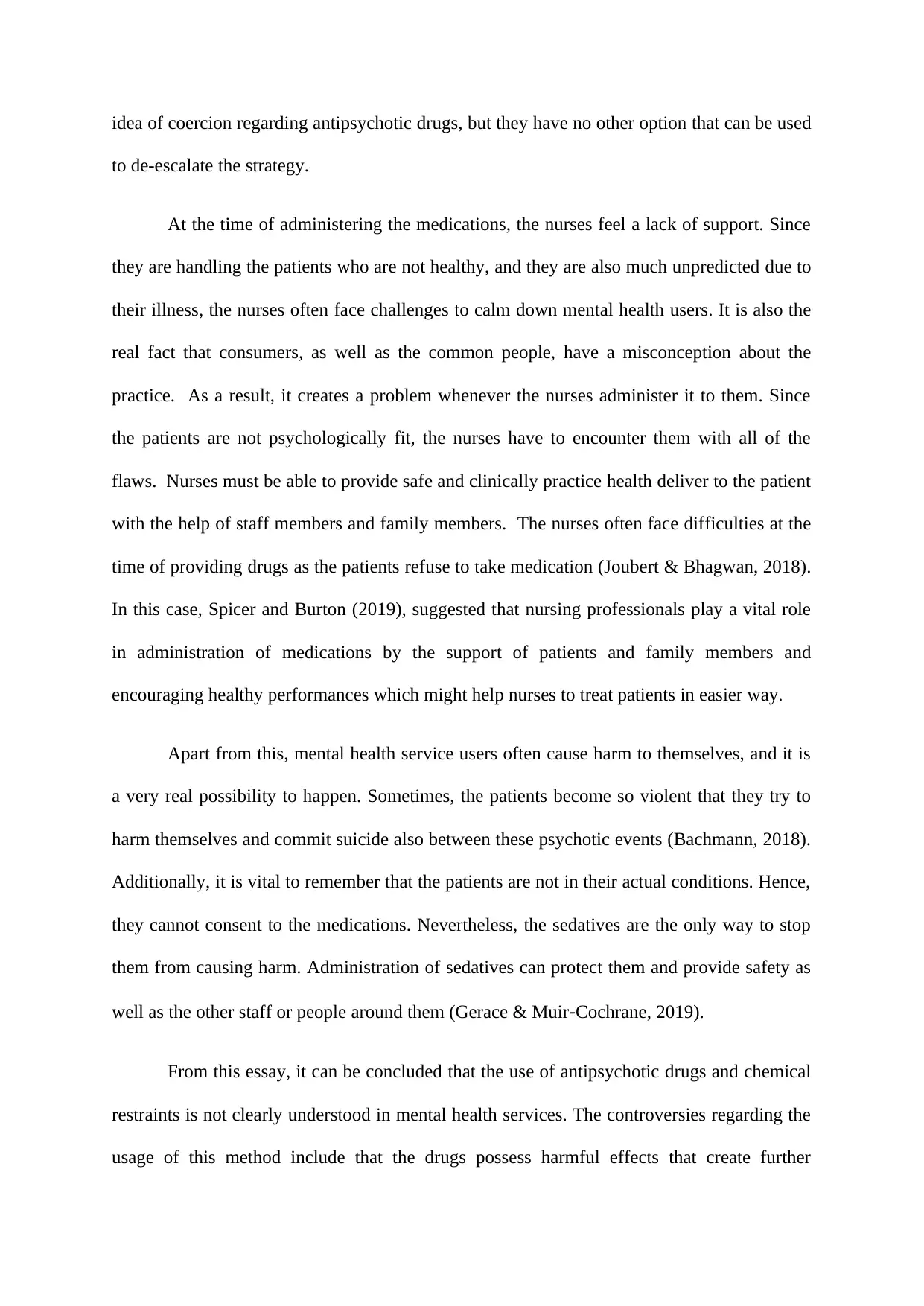
idea of coercion regarding antipsychotic drugs, but they have no other option that can be used
to de-escalate the strategy.
At the time of administering the medications, the nurses feel a lack of support. Since
they are handling the patients who are not healthy, and they are also much unpredicted due to
their illness, the nurses often face challenges to calm down mental health users. It is also the
real fact that consumers, as well as the common people, have a misconception about the
practice. As a result, it creates a problem whenever the nurses administer it to them. Since
the patients are not psychologically fit, the nurses have to encounter them with all of the
flaws. Nurses must be able to provide safe and clinically practice health deliver to the patient
with the help of staff members and family members. The nurses often face difficulties at the
time of providing drugs as the patients refuse to take medication (Joubert & Bhagwan, 2018).
In this case, Spicer and Burton (2019), suggested that nursing professionals play a vital role
in administration of medications by the support of patients and family members and
encouraging healthy performances which might help nurses to treat patients in easier way.
Apart from this, mental health service users often cause harm to themselves, and it is
a very real possibility to happen. Sometimes, the patients become so violent that they try to
harm themselves and commit suicide also between these psychotic events (Bachmann, 2018).
Additionally, it is vital to remember that the patients are not in their actual conditions. Hence,
they cannot consent to the medications. Nevertheless, the sedatives are the only way to stop
them from causing harm. Administration of sedatives can protect them and provide safety as
well as the other staff or people around them (Gerace & Muir‐Cochrane, 2019).
From this essay, it can be concluded that the use of antipsychotic drugs and chemical
restraints is not clearly understood in mental health services. The controversies regarding the
usage of this method include that the drugs possess harmful effects that create further
to de-escalate the strategy.
At the time of administering the medications, the nurses feel a lack of support. Since
they are handling the patients who are not healthy, and they are also much unpredicted due to
their illness, the nurses often face challenges to calm down mental health users. It is also the
real fact that consumers, as well as the common people, have a misconception about the
practice. As a result, it creates a problem whenever the nurses administer it to them. Since
the patients are not psychologically fit, the nurses have to encounter them with all of the
flaws. Nurses must be able to provide safe and clinically practice health deliver to the patient
with the help of staff members and family members. The nurses often face difficulties at the
time of providing drugs as the patients refuse to take medication (Joubert & Bhagwan, 2018).
In this case, Spicer and Burton (2019), suggested that nursing professionals play a vital role
in administration of medications by the support of patients and family members and
encouraging healthy performances which might help nurses to treat patients in easier way.
Apart from this, mental health service users often cause harm to themselves, and it is
a very real possibility to happen. Sometimes, the patients become so violent that they try to
harm themselves and commit suicide also between these psychotic events (Bachmann, 2018).
Additionally, it is vital to remember that the patients are not in their actual conditions. Hence,
they cannot consent to the medications. Nevertheless, the sedatives are the only way to stop
them from causing harm. Administration of sedatives can protect them and provide safety as
well as the other staff or people around them (Gerace & Muir‐Cochrane, 2019).
From this essay, it can be concluded that the use of antipsychotic drugs and chemical
restraints is not clearly understood in mental health services. The controversies regarding the
usage of this method include that the drugs possess harmful effects that create further
⊘ This is a preview!⊘
Do you want full access?
Subscribe today to unlock all pages.

Trusted by 1+ million students worldwide
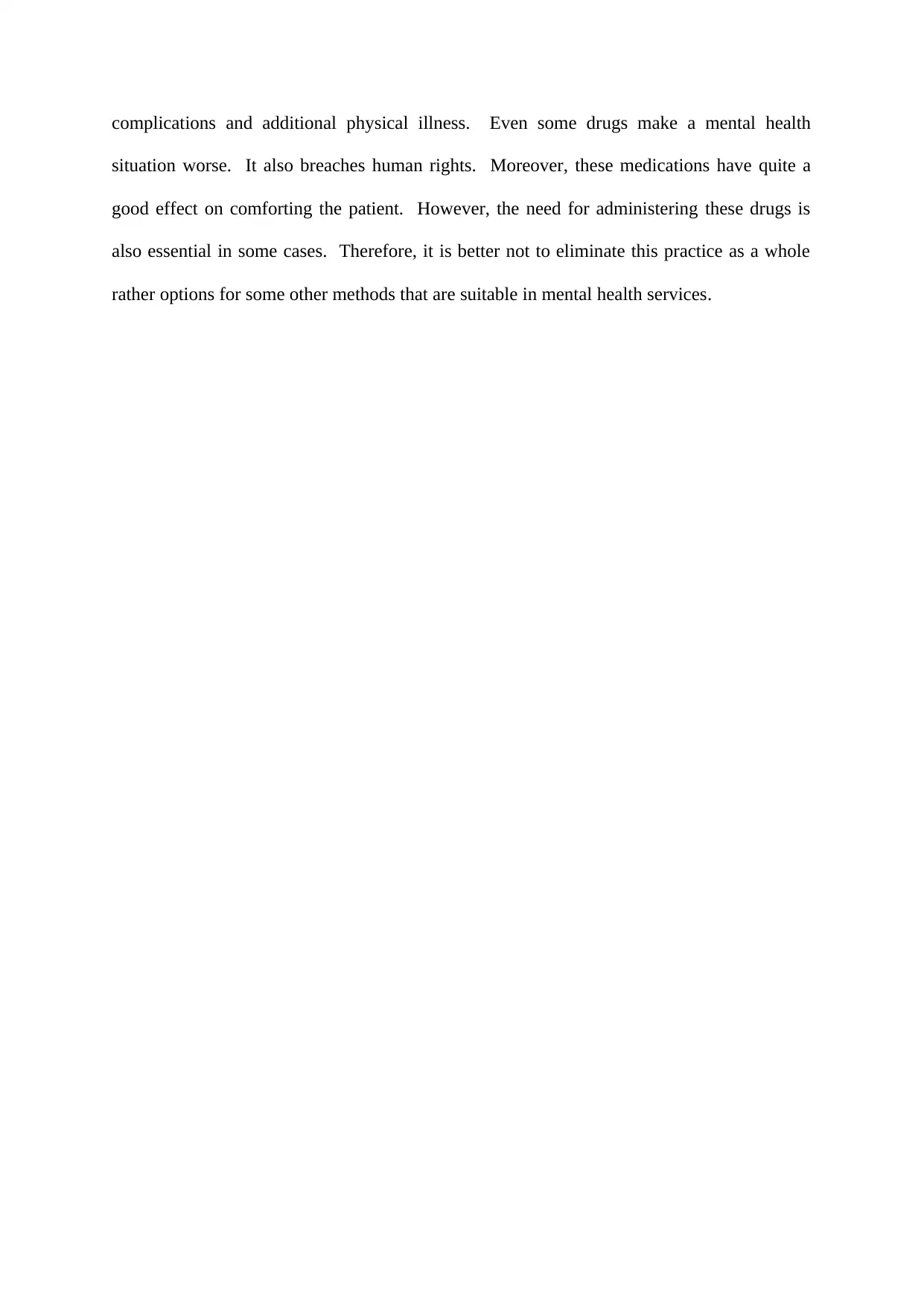
complications and additional physical illness. Even some drugs make a mental health
situation worse. It also breaches human rights. Moreover, these medications have quite a
good effect on comforting the patient. However, the need for administering these drugs is
also essential in some cases. Therefore, it is better not to eliminate this practice as a whole
rather options for some other methods that are suitable in mental health services.
situation worse. It also breaches human rights. Moreover, these medications have quite a
good effect on comforting the patient. However, the need for administering these drugs is
also essential in some cases. Therefore, it is better not to eliminate this practice as a whole
rather options for some other methods that are suitable in mental health services.
Paraphrase This Document
Need a fresh take? Get an instant paraphrase of this document with our AI Paraphraser
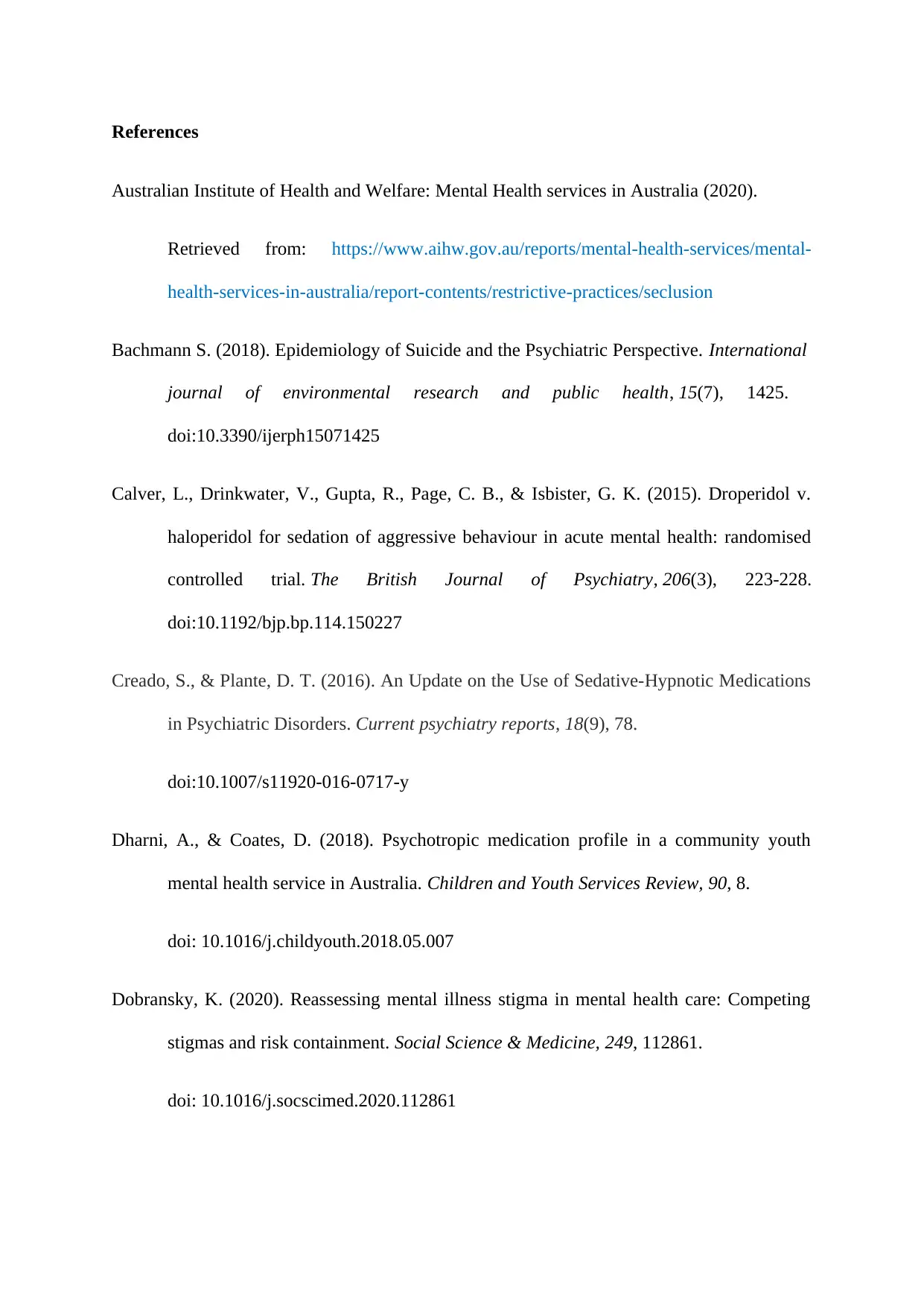
References
Australian Institute of Health and Welfare: Mental Health services in Australia (2020).
Retrieved from: https://www.aihw.gov.au/reports/mental-health-services/mental-
health-services-in-australia/report-contents/restrictive-practices/seclusion
Bachmann S. (2018). Epidemiology of Suicide and the Psychiatric Perspective. International
journal of environmental research and public health, 15(7), 1425.
doi:10.3390/ijerph15071425
Calver, L., Drinkwater, V., Gupta, R., Page, C. B., & Isbister, G. K. (2015). Droperidol v.
haloperidol for sedation of aggressive behaviour in acute mental health: randomised
controlled trial. The British Journal of Psychiatry, 206(3), 223-228.
doi:10.1192/bjp.bp.114.150227
Creado, S., & Plante, D. T. (2016). An Update on the Use of Sedative-Hypnotic Medications
in Psychiatric Disorders. Current psychiatry reports, 18(9), 78.
doi:10.1007/s11920-016-0717-y
Dharni, A., & Coates, D. (2018). Psychotropic medication profile in a community youth
mental health service in Australia. Children and Youth Services Review, 90, 8.
doi: 10.1016/j.childyouth.2018.05.007
Dobransky, K. (2020). Reassessing mental illness stigma in mental health care: Competing
stigmas and risk containment. Social Science & Medicine, 249, 112861.
doi: 10.1016/j.socscimed.2020.112861
Australian Institute of Health and Welfare: Mental Health services in Australia (2020).
Retrieved from: https://www.aihw.gov.au/reports/mental-health-services/mental-
health-services-in-australia/report-contents/restrictive-practices/seclusion
Bachmann S. (2018). Epidemiology of Suicide and the Psychiatric Perspective. International
journal of environmental research and public health, 15(7), 1425.
doi:10.3390/ijerph15071425
Calver, L., Drinkwater, V., Gupta, R., Page, C. B., & Isbister, G. K. (2015). Droperidol v.
haloperidol for sedation of aggressive behaviour in acute mental health: randomised
controlled trial. The British Journal of Psychiatry, 206(3), 223-228.
doi:10.1192/bjp.bp.114.150227
Creado, S., & Plante, D. T. (2016). An Update on the Use of Sedative-Hypnotic Medications
in Psychiatric Disorders. Current psychiatry reports, 18(9), 78.
doi:10.1007/s11920-016-0717-y
Dharni, A., & Coates, D. (2018). Psychotropic medication profile in a community youth
mental health service in Australia. Children and Youth Services Review, 90, 8.
doi: 10.1016/j.childyouth.2018.05.007
Dobransky, K. (2020). Reassessing mental illness stigma in mental health care: Competing
stigmas and risk containment. Social Science & Medicine, 249, 112861.
doi: 10.1016/j.socscimed.2020.112861
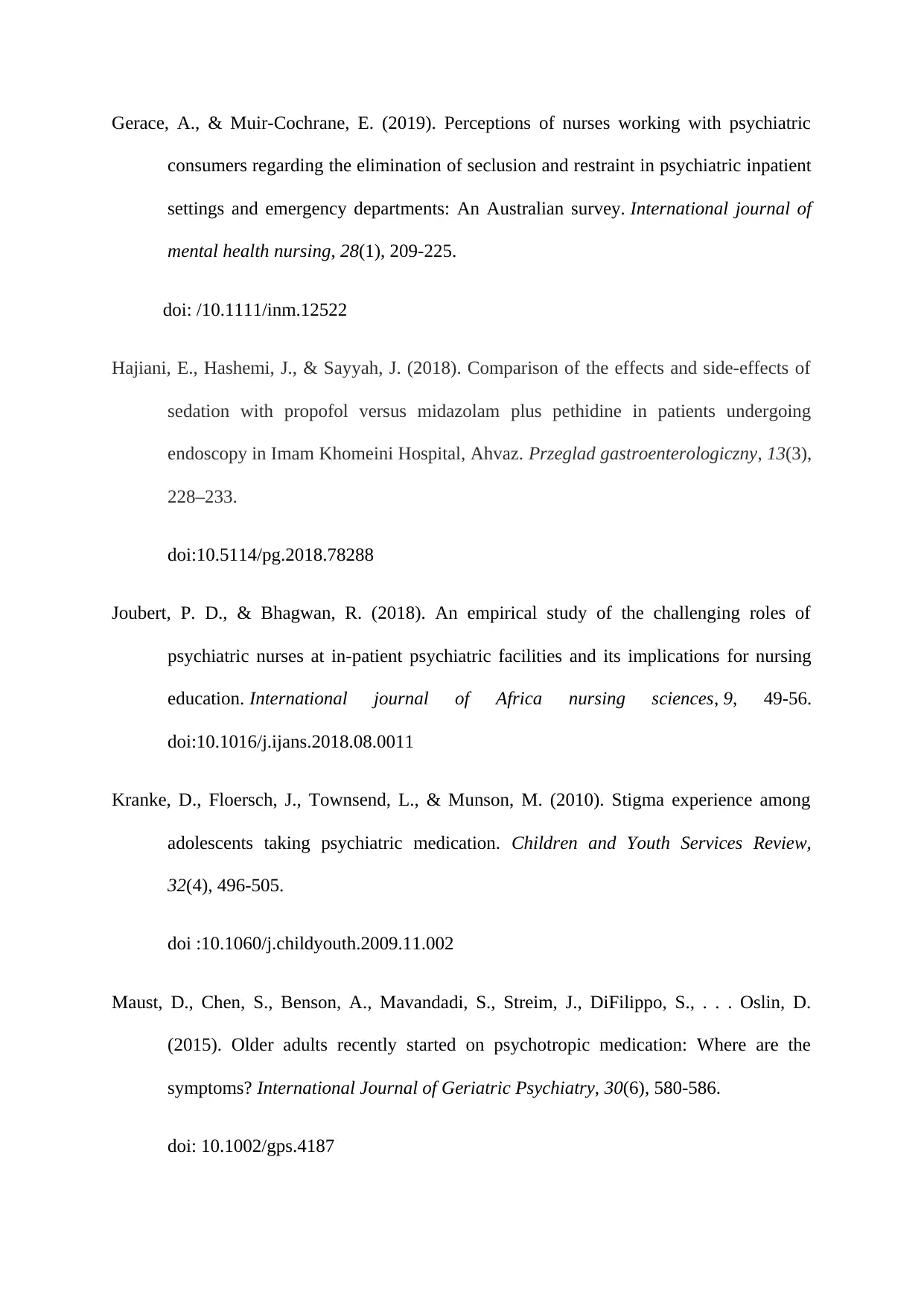
Gerace, A., & Muir‐Cochrane, E. (2019). Perceptions of nurses working with psychiatric
consumers regarding the elimination of seclusion and restraint in psychiatric inpatient
settings and emergency departments: An Australian survey. International journal of
mental health nursing, 28(1), 209-225.
doi: /10.1111/inm.12522
Hajiani, E., Hashemi, J., & Sayyah, J. (2018). Comparison of the effects and side-effects of
sedation with propofol versus midazolam plus pethidine in patients undergoing
endoscopy in Imam Khomeini Hospital, Ahvaz. Przeglad gastroenterologiczny, 13(3),
228–233.
doi:10.5114/pg.2018.78288
Joubert, P. D., & Bhagwan, R. (2018). An empirical study of the challenging roles of
psychiatric nurses at in-patient psychiatric facilities and its implications for nursing
education. International journal of Africa nursing sciences, 9, 49-56.
doi:10.1016/j.ijans.2018.08.0011
Kranke, D., Floersch, J., Townsend, L., & Munson, M. (2010). Stigma experience among
adolescents taking psychiatric medication. Children and Youth Services Review,
32(4), 496-505.
doi :10.1060/j.childyouth.2009.11.002
Maust, D., Chen, S., Benson, A., Mavandadi, S., Streim, J., DiFilippo, S., . . . Oslin, D.
(2015). Older adults recently started on psychotropic medication: Where are the
symptoms? International Journal of Geriatric Psychiatry, 30(6), 580-586.
doi: 10.1002/gps.4187
consumers regarding the elimination of seclusion and restraint in psychiatric inpatient
settings and emergency departments: An Australian survey. International journal of
mental health nursing, 28(1), 209-225.
doi: /10.1111/inm.12522
Hajiani, E., Hashemi, J., & Sayyah, J. (2018). Comparison of the effects and side-effects of
sedation with propofol versus midazolam plus pethidine in patients undergoing
endoscopy in Imam Khomeini Hospital, Ahvaz. Przeglad gastroenterologiczny, 13(3),
228–233.
doi:10.5114/pg.2018.78288
Joubert, P. D., & Bhagwan, R. (2018). An empirical study of the challenging roles of
psychiatric nurses at in-patient psychiatric facilities and its implications for nursing
education. International journal of Africa nursing sciences, 9, 49-56.
doi:10.1016/j.ijans.2018.08.0011
Kranke, D., Floersch, J., Townsend, L., & Munson, M. (2010). Stigma experience among
adolescents taking psychiatric medication. Children and Youth Services Review,
32(4), 496-505.
doi :10.1060/j.childyouth.2009.11.002
Maust, D., Chen, S., Benson, A., Mavandadi, S., Streim, J., DiFilippo, S., . . . Oslin, D.
(2015). Older adults recently started on psychotropic medication: Where are the
symptoms? International Journal of Geriatric Psychiatry, 30(6), 580-586.
doi: 10.1002/gps.4187
⊘ This is a preview!⊘
Do you want full access?
Subscribe today to unlock all pages.

Trusted by 1+ million students worldwide
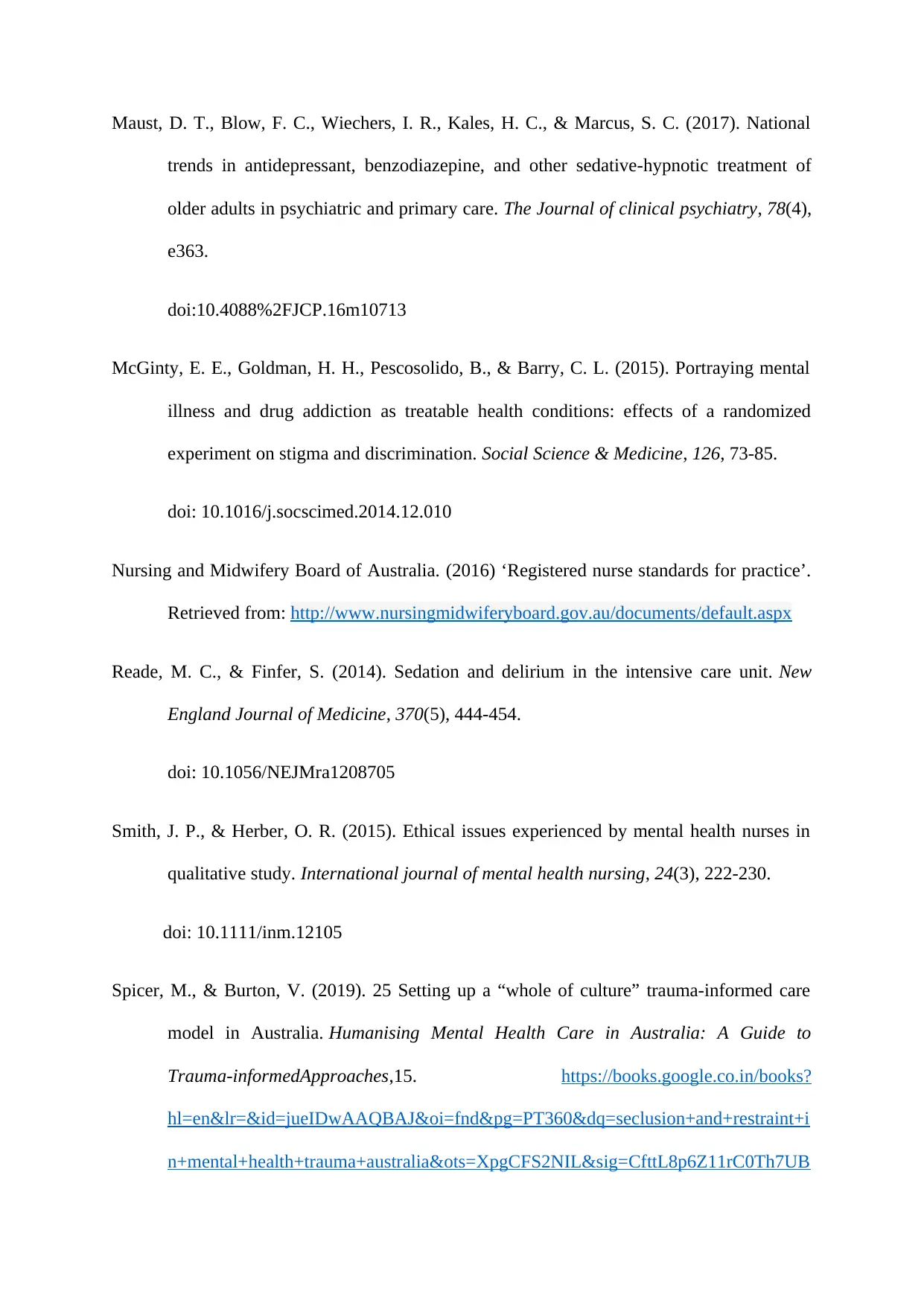
Maust, D. T., Blow, F. C., Wiechers, I. R., Kales, H. C., & Marcus, S. C. (2017). National
trends in antidepressant, benzodiazepine, and other sedative-hypnotic treatment of
older adults in psychiatric and primary care. The Journal of clinical psychiatry, 78(4),
e363.
doi:10.4088%2FJCP.16m10713
McGinty, E. E., Goldman, H. H., Pescosolido, B., & Barry, C. L. (2015). Portraying mental
illness and drug addiction as treatable health conditions: effects of a randomized
experiment on stigma and discrimination. Social Science & Medicine, 126, 73-85.
doi: 10.1016/j.socscimed.2014.12.010
Nursing and Midwifery Board of Australia. (2016) ‘Registered nurse standards for practice’.
Retrieved from: http://www.nursingmidwiferyboard.gov.au/documents/default.aspx
Reade, M. C., & Finfer, S. (2014). Sedation and delirium in the intensive care unit. New
England Journal of Medicine, 370(5), 444-454.
doi: 10.1056/NEJMra1208705
Smith, J. P., & Herber, O. R. (2015). Ethical issues experienced by mental health nurses in
qualitative study. International journal of mental health nursing, 24(3), 222-230.
doi: 10.1111/inm.12105
Spicer, M., & Burton, V. (2019). 25 Setting up a “whole of culture” trauma-informed care
model in Australia. Humanising Mental Health Care in Australia: A Guide to
Trauma-informedApproaches,15. https://books.google.co.in/books?
hl=en&lr=&id=jueIDwAAQBAJ&oi=fnd&pg=PT360&dq=seclusion+and+restraint+i
n+mental+health+trauma+australia&ots=XpgCFS2NIL&sig=CfttL8p6Z11rC0Th7UB
trends in antidepressant, benzodiazepine, and other sedative-hypnotic treatment of
older adults in psychiatric and primary care. The Journal of clinical psychiatry, 78(4),
e363.
doi:10.4088%2FJCP.16m10713
McGinty, E. E., Goldman, H. H., Pescosolido, B., & Barry, C. L. (2015). Portraying mental
illness and drug addiction as treatable health conditions: effects of a randomized
experiment on stigma and discrimination. Social Science & Medicine, 126, 73-85.
doi: 10.1016/j.socscimed.2014.12.010
Nursing and Midwifery Board of Australia. (2016) ‘Registered nurse standards for practice’.
Retrieved from: http://www.nursingmidwiferyboard.gov.au/documents/default.aspx
Reade, M. C., & Finfer, S. (2014). Sedation and delirium in the intensive care unit. New
England Journal of Medicine, 370(5), 444-454.
doi: 10.1056/NEJMra1208705
Smith, J. P., & Herber, O. R. (2015). Ethical issues experienced by mental health nurses in
qualitative study. International journal of mental health nursing, 24(3), 222-230.
doi: 10.1111/inm.12105
Spicer, M., & Burton, V. (2019). 25 Setting up a “whole of culture” trauma-informed care
model in Australia. Humanising Mental Health Care in Australia: A Guide to
Trauma-informedApproaches,15. https://books.google.co.in/books?
hl=en&lr=&id=jueIDwAAQBAJ&oi=fnd&pg=PT360&dq=seclusion+and+restraint+i
n+mental+health+trauma+australia&ots=XpgCFS2NIL&sig=CfttL8p6Z11rC0Th7UB
Paraphrase This Document
Need a fresh take? Get an instant paraphrase of this document with our AI Paraphraser
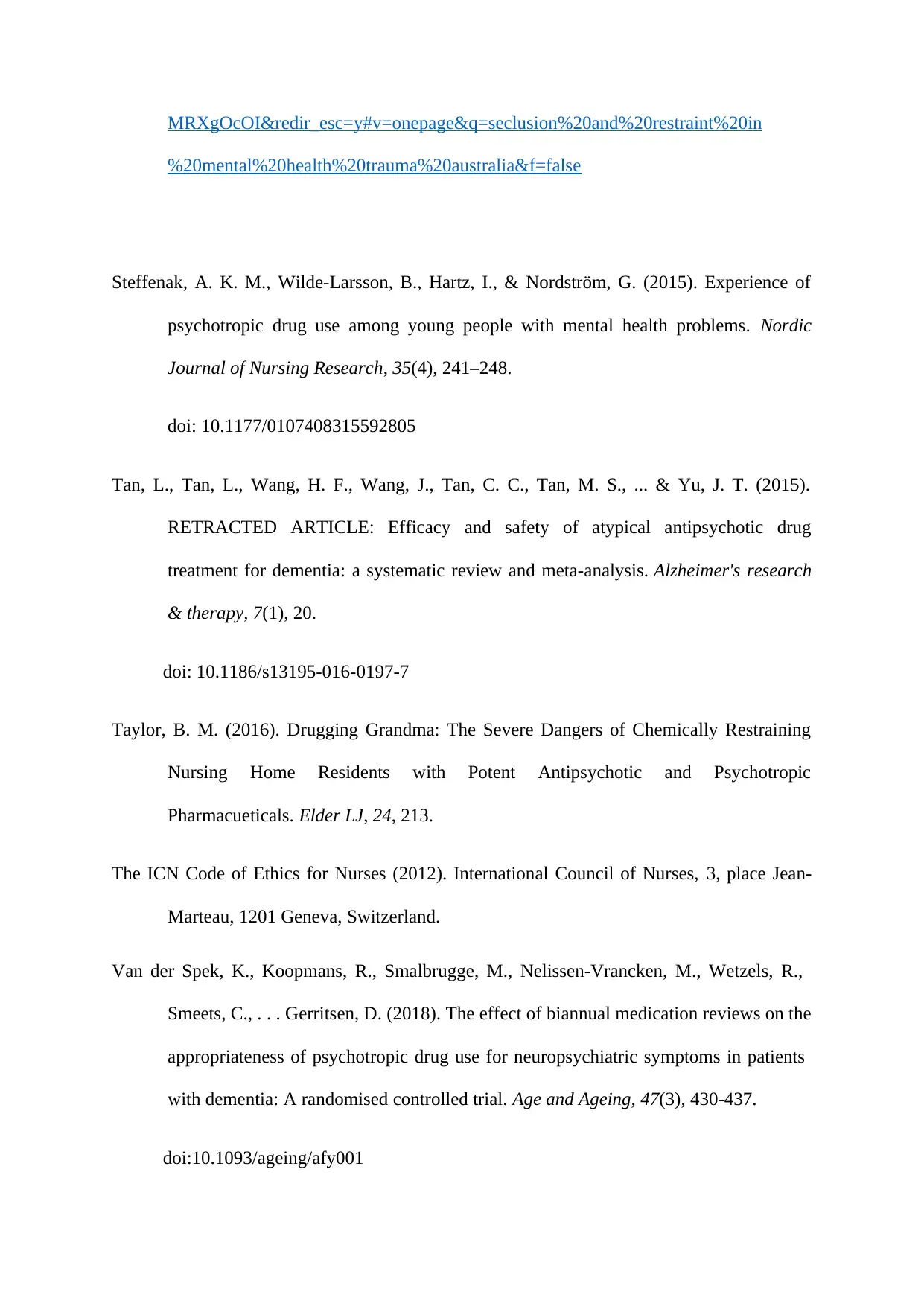
MRXgOcOI&redir_esc=y#v=onepage&q=seclusion%20and%20restraint%20in
%20mental%20health%20trauma%20australia&f=false
Steffenak, A. K. M., Wilde-Larsson, B., Hartz, I., & Nordström, G. (2015). Experience of
psychotropic drug use among young people with mental health problems. Nordic
Journal of Nursing Research, 35(4), 241–248.
doi: 10.1177/0107408315592805
Tan, L., Tan, L., Wang, H. F., Wang, J., Tan, C. C., Tan, M. S., ... & Yu, J. T. (2015).
RETRACTED ARTICLE: Efficacy and safety of atypical antipsychotic drug
treatment for dementia: a systematic review and meta-analysis. Alzheimer's research
& therapy, 7(1), 20.
doi: 10.1186/s13195-016-0197-7
Taylor, B. M. (2016). Drugging Grandma: The Severe Dangers of Chemically Restraining
Nursing Home Residents with Potent Antipsychotic and Psychotropic
Pharmacueticals. Elder LJ, 24, 213.
The ICN Code of Ethics for Nurses (2012). International Council of Nurses, 3, place Jean-
Marteau, 1201 Geneva, Switzerland.
Van der Spek, K., Koopmans, R., Smalbrugge, M., Nelissen-Vrancken, M., Wetzels, R.,
Smeets, C., . . . Gerritsen, D. (2018). The effect of biannual medication reviews on the
appropriateness of psychotropic drug use for neuropsychiatric symptoms in patients
with dementia: A randomised controlled trial. Age and Ageing, 47(3), 430-437.
doi:10.1093/ageing/afy001
%20mental%20health%20trauma%20australia&f=false
Steffenak, A. K. M., Wilde-Larsson, B., Hartz, I., & Nordström, G. (2015). Experience of
psychotropic drug use among young people with mental health problems. Nordic
Journal of Nursing Research, 35(4), 241–248.
doi: 10.1177/0107408315592805
Tan, L., Tan, L., Wang, H. F., Wang, J., Tan, C. C., Tan, M. S., ... & Yu, J. T. (2015).
RETRACTED ARTICLE: Efficacy and safety of atypical antipsychotic drug
treatment for dementia: a systematic review and meta-analysis. Alzheimer's research
& therapy, 7(1), 20.
doi: 10.1186/s13195-016-0197-7
Taylor, B. M. (2016). Drugging Grandma: The Severe Dangers of Chemically Restraining
Nursing Home Residents with Potent Antipsychotic and Psychotropic
Pharmacueticals. Elder LJ, 24, 213.
The ICN Code of Ethics for Nurses (2012). International Council of Nurses, 3, place Jean-
Marteau, 1201 Geneva, Switzerland.
Van der Spek, K., Koopmans, R., Smalbrugge, M., Nelissen-Vrancken, M., Wetzels, R.,
Smeets, C., . . . Gerritsen, D. (2018). The effect of biannual medication reviews on the
appropriateness of psychotropic drug use for neuropsychiatric symptoms in patients
with dementia: A randomised controlled trial. Age and Ageing, 47(3), 430-437.
doi:10.1093/ageing/afy001
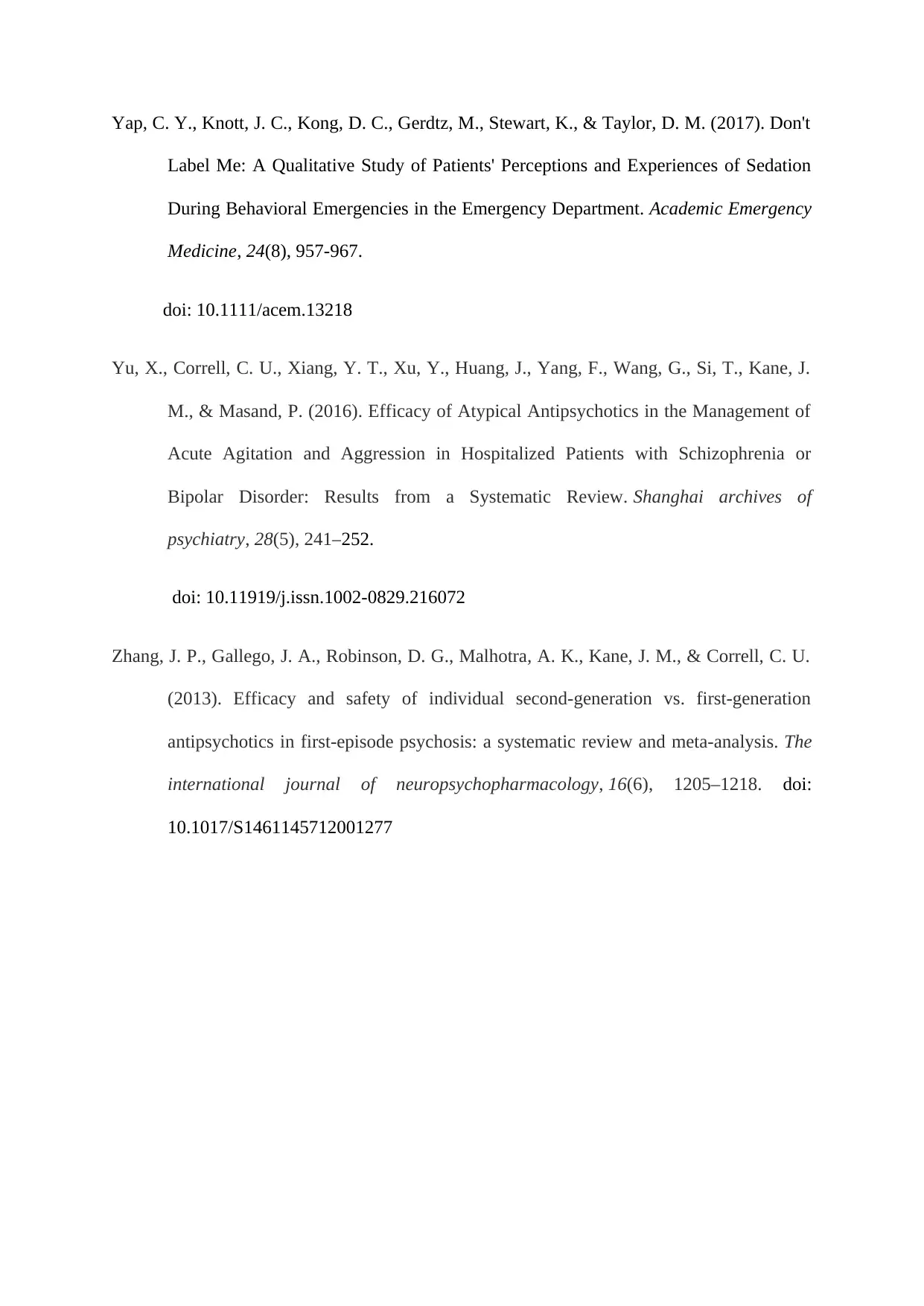
Yap, C. Y., Knott, J. C., Kong, D. C., Gerdtz, M., Stewart, K., & Taylor, D. M. (2017). Don't
Label Me: A Qualitative Study of Patients' Perceptions and Experiences of Sedation
During Behavioral Emergencies in the Emergency Department. Academic Emergency
Medicine, 24(8), 957-967.
doi: 10.1111/acem.13218
Yu, X., Correll, C. U., Xiang, Y. T., Xu, Y., Huang, J., Yang, F., Wang, G., Si, T., Kane, J.
M., & Masand, P. (2016). Efficacy of Atypical Antipsychotics in the Management of
Acute Agitation and Aggression in Hospitalized Patients with Schizophrenia or
Bipolar Disorder: Results from a Systematic Review. Shanghai archives of
psychiatry, 28(5), 241–252.
doi: 10.11919/j.issn.1002-0829.216072
Zhang, J. P., Gallego, J. A., Robinson, D. G., Malhotra, A. K., Kane, J. M., & Correll, C. U.
(2013). Efficacy and safety of individual second-generation vs. first-generation
antipsychotics in first-episode psychosis: a systematic review and meta-analysis. The
international journal of neuropsychopharmacology, 16(6), 1205–1218. doi:
10.1017/S1461145712001277
Label Me: A Qualitative Study of Patients' Perceptions and Experiences of Sedation
During Behavioral Emergencies in the Emergency Department. Academic Emergency
Medicine, 24(8), 957-967.
doi: 10.1111/acem.13218
Yu, X., Correll, C. U., Xiang, Y. T., Xu, Y., Huang, J., Yang, F., Wang, G., Si, T., Kane, J.
M., & Masand, P. (2016). Efficacy of Atypical Antipsychotics in the Management of
Acute Agitation and Aggression in Hospitalized Patients with Schizophrenia or
Bipolar Disorder: Results from a Systematic Review. Shanghai archives of
psychiatry, 28(5), 241–252.
doi: 10.11919/j.issn.1002-0829.216072
Zhang, J. P., Gallego, J. A., Robinson, D. G., Malhotra, A. K., Kane, J. M., & Correll, C. U.
(2013). Efficacy and safety of individual second-generation vs. first-generation
antipsychotics in first-episode psychosis: a systematic review and meta-analysis. The
international journal of neuropsychopharmacology, 16(6), 1205–1218. doi:
10.1017/S1461145712001277
⊘ This is a preview!⊘
Do you want full access?
Subscribe today to unlock all pages.

Trusted by 1+ million students worldwide
1 out of 12
Related Documents
Your All-in-One AI-Powered Toolkit for Academic Success.
+13062052269
info@desklib.com
Available 24*7 on WhatsApp / Email
![[object Object]](/_next/static/media/star-bottom.7253800d.svg)
Unlock your academic potential
Copyright © 2020–2025 A2Z Services. All Rights Reserved. Developed and managed by ZUCOL.





